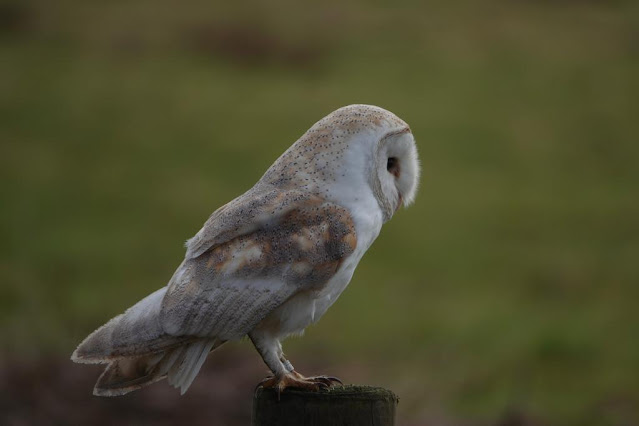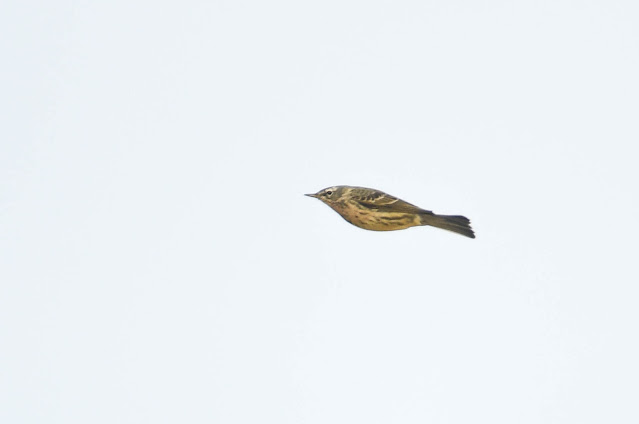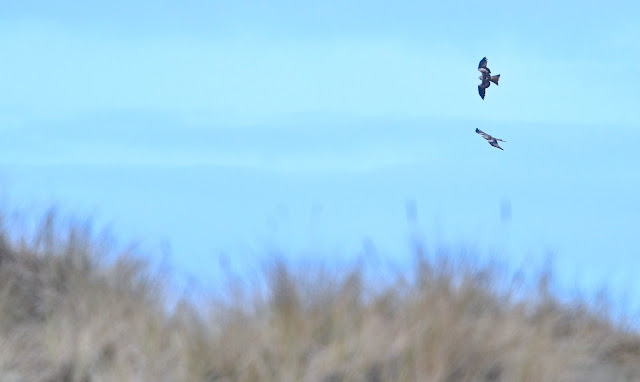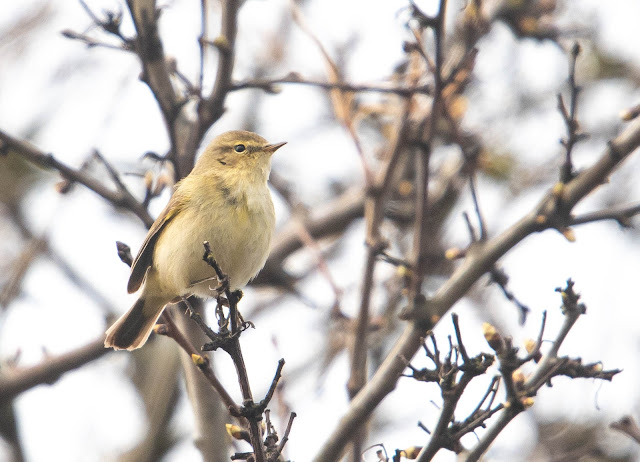The flooded field near Commissioner's Drain continued its recent run of good waders with a Knot seen by Tim on March 1st. On the 3rd it also produced 38 Dunlin and a Redshank for Mick. On the 4th, Pat finally caught up with a Russian White-fronted Goose amongst the Pinks, along with the three Barnacle Geese and several Brent Geese. Mick had a flyover Lapland Bunting on the same day, whilst Tim located the two Tundra Bean Geese again. Meanwhile, back near Commissioner's Drain a Barn Owl performed very nicely for Pat's camera.
Just outside of the patch from the Horsey Road but of note anyway was this interesting Cackling Goose, presumably minima if not a hybrid. It was initially found by Barry, and also photographed by Pat.
The early part of March saw the Peregrine become a virtual resident on the the church tower, and Pat was even able to video it on several occasions from his garden!
On the 6th March the number of Tundra Bean Geese went up to three (Tim) and a Great White Egret was noted again in the north of the parish. Short-eared Owls were seen occasionally through the month, including one seen unusually near to the village by Pat on the 7th.
On the 7th Barry saw a Rock Pipit on one of the groynes to the north of the village, and this proved to be the first of quite a few, including this finely plumaged, clear Scandinavian/littoralis bird with its rosy flushed breast, strong supercilium and almost Water Pipit greys on its head and back. It is apparently the case that almost all our Rock Pipits in Norfolk are likely to be littoralis rather than petrosus (see the 2019 Norfolk Bird and Mammal Report), a fact I was blissfully unaware of, since they are only separable in the spring, until I Tweeted this image and received some really interesting followups about it including an article from the 1995 NBMR on "The Origins of Rock Pipits in Norfolk".
Here's another shot of another Rock Pipit which stayed below the remains of the cafe for a couple of days.
On the 11th Mick had the first Sand Martin of the year whist seawatching, and he also saw the second on the 29th.
On the 14th Tim saw another Red Kite over the village. There were a number of Eider seen flying past throughout the month including two males south on this date. On the 15th Colin saw another two Red Kites in the North Dunes, which lingered and loafed about in the wind for quite a while.
The Peregrine was still spending a lot of time on the church tower around this time.
On the 17th a morning seawatch produced a Pintail, the usual Iceland Gull, identifiable by its right wing, a Fulmar and a fairly big movement of Gannets and Red-throated Divers for Sean - these two latter species continued to be noted in large numbers quite frequently until the month's end.
On the 19th Maynard heard a Water Rail, and saw a Bullfinch and several Treecreepers.
On the 20th much excitement for patch listers when Mick called in 10 Canada Geese (patch gold) which he had seen from Commissioner's Drain. Several quick-off-the-mark Collective members managed to connect, but by the time some of us arrived they were long gone. I can hardly bear to post Mick's picture...
Patrick noted the first flock of Siskin of the year, also on the 20th, and the Iceland Gull was still patrolling up and down the beach.
On the 21st Mick had a good seawatch, recording Great Crested Grebe, Shag, and two Great Northern Divers.
On the 22nd Peter saw two Brambling in the recently cut maize patch on Low Road, and in the afternoon Sean found a distant White-tailed Eagle north of the Holmes Road, which caused pandemonium in the geese flock and then lumbered low through the famland, heading inland. Given the number of eagles to the south of us and the north, it was not an entirely unexpected event.
Also on that day Sean took a picture of a lovely male Hen Harrier passing through the Pink-footed Geese flock without noticing that he had also unknowingly photographed a couple of the Tundra Bean Geese! Social media to the rescue again!
Luckily for the Collective year-listers, the eagle was also present the next day and for the following few days, when it was also joined by another!
On the night of 22nd-23rd Sean night-recorded the calls of both Water Rail and Coot (a mega rarity during the day but surprisingly common in nocmig recordings), as well as some nice Common Scoter calls.
On the 23rd Pete found a Firecrest in his garden and generously put the news out, allowing safe and socially distanced viewing of the bird from outside of his property. No lockdown rules were broken but most of us managed to add it to our year lists. In fact, Sean added both Firecrest and Goldcrest to his on the same day!
Chiffchaffs had been present on the patch since about the second week of March, but none had been singing until one in the valley, also on the morning of the 23rd. This uncorked the bottle: there must have been a big arrival overnight as on the 24th there were many songsters on the patch.
It was also a pleasure that morning to hear this Song Thrush pouring out his heart in the valley.
On the 25th Sean had three White Wagtails on the ploughed field to the south of the village, and over the next few days several more were seen.
Also over the following few days there were more Red Kites, Bramblings and White-tailed Eagle sightings continued.
On the 26th Barry found a Black Redstart in the valley and the next morning day Sean saw two there, then Tim topped that with three in the afternoon. This was nothing though as on the following Barry managed to see five together in the Paddocks!



















